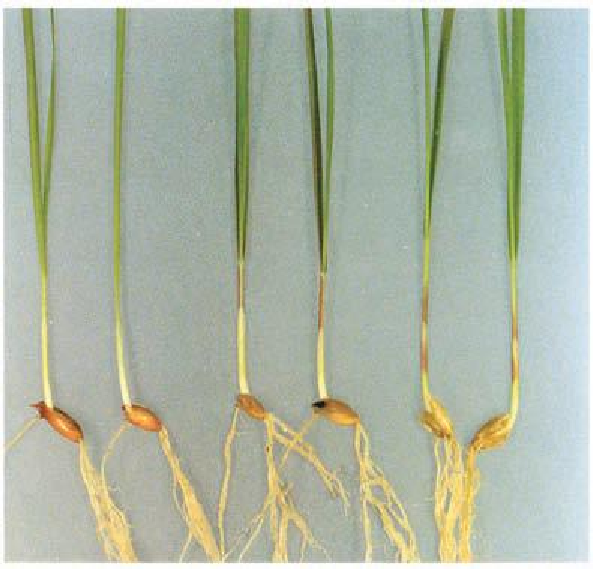Agriculture Reference
In-Depth Information
Figure 9.22. Oat seedling coleoptile and leaf sheath color: Green coleoptile and leaf sheath (left), green cole-
optile and red leaf sheath (middle), and red coleoptile and leaf sheath (right).
Soybean seedlings (Fig. 9.23) may be classiied as green (green pigmentation only), bronze (bronze
pigment on the lower hypocotyl), light purple (purple hypocotyl, green epicotyl) and dark purple (dark
purple hypocotyl and epicotyl). Twenty-one days after emergence, fully expanded trifoliate lealets of soy-
bean plants can be evaluated for angle of the pubescence on the upper lealet surface (erect, appressed or
intermediate), pubescence color (tawny or gray, Fig. 9.24), and lealet shape (ovate-length/width ratio less
than 1.6 or lanceolate length/width ratio over 2.0, Fig. 9.25). The procedures are useful for differentiating
varieties as well as off-types.
During the metribuzin test, plants should be evaluated daily for injury. Signs of injury are the appear-
ance of brown spots, desiccation and curling of leaves, leaf drop and death of plants. Varieties which show
signs of injury after nine days and are dead after 17 days are most sensitive. Those showing injury after 13
days and are dead after 32 days are moderately sensitive; and those showing injury after 20 days and which
survive 30 days after application are least sensitive. The photoperiod test consists of recording the number
of days from planting to lowering for soybean plants grown under various photoperiods. This procedure
can be used to separate varieties in different maturity groups. Four to six weeks after planting, observations
of lower color can be made on sweetclover plants. The number of plants with lowers that are either yellow
(indicating yellow sweetclover) or white (white sweetclover) is recorded. This procedure is useful for dif-
ferentiating the two species of sweetclover as well as detecting mixtures of the two species.
Wheat seedlings can be evaluated approximately seven days after planting to determine if the cole-
optile and stem color is purple or green (Fig. 9.26). About 30 days after emergence, wheat plants can be
observed to determine if they are heading (spring wheat) or not heading (winter wheat). These testing pro-
cedures can be used to differentiate varieties as well as to detect off-types.
The evaluation characteristics of seedlings and plants is summarized in Table 9.4.

